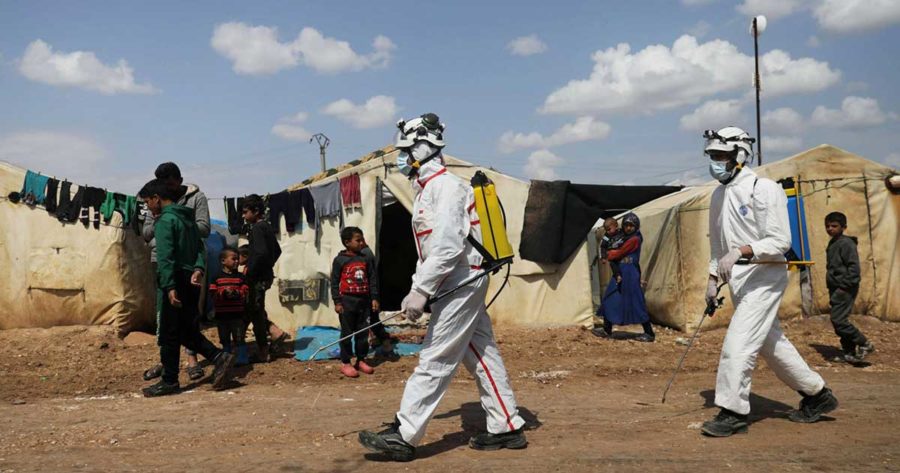
In Syria, collapse is a recurring theme in most vital sectors. This time, the next blow is coming for the healthcare sector in the form of Coronavirus, exposing its fragility.
The regime which discloses a very limited number of cases, has been accused by international bodies and organizations of deceiving the public and the World Health Organization, as the virus is said to have totaled a number of infections much higher than officially declared. This comes amid warnings by these organizations of serious repercussions the epidemic could cause the war-torn country that has already exhausted its healthcare and economic capabilities.
Repeated Warnings
Initially, it was the United Nations through the Political affairs Officer Rosemary DiCarlo, who warned of the devastating potential impact of the pandemic in Syria, especially in Idlib. Meanwhile, the Norwegian Refugee Council advisor, Rachel Sider, went on to say that Syria will be the country most vulnerable to this epidemic globally in light of the deteriorating conditions of many Syrian cities where basic health systems and infrastructure were destroyed.
Read more: Bassam al-Hallak.. When Tragedy Struck the Downtrodden
On the other hand, the World Health Organization (WHO) estimated that the disease would lead to an outbreak in Syria by next May. The head of the World Health Organization (WHO) East Mediterranean office of communicable disease control, Abd al-Nasser Abu Bakr predicted, in a phone call to CNN on March 18 “an explosion of cases to occur in the countries that suffer from a weak healthcare system. ”
Syrian Regions
According to United Nations data, by the end of the past year 2019, only 64% of hospitals and 52% of primary health care centers in all parts of Syria were operating at full capacity; in addition, nearly 70% of workers in the health sector in Syria had left their positions. Based on those reports, The International Organization predicts Syria’s inability to face the epidemic.
According to an internal United Nations report, prepared by the London School of Economics’s Conflict Research Program published late March, the maximum hospital capacity for Coronavirus infections that can be treated in Syria is about 6500; of which there are only 325 intensive care units equipped with ventilators.
The report notes that “Once the number of registered cases exceeds 6500 cases, the health care system is expected to collapse and rationing policies to arise. Consequently, the overall mortality rates are expected to climb to at least 5% among infected cases.”
In Northern Syria, the situation appears catastrophic at the outset. In that region consisting of Idlib and the rural triangle between Aleppo, Hama, and Lattikiah, resides over three and a half million Syrians. Among those are over one million Syrians displaced by the civil war and are living in refugee camps with limited or no access to water or sanitation products.
The New York Times cited doctors in Northern Syria who estimated that: “About one million people may become infected by the virus in Idlib, and that about 100,000 to 120,000 of them could die. 10,000 will need ventilators, yet there is currently only 150 available.”
The situation is the same in the regions of East Euphrates, where the Kurds, Americans and Turks share control of the region that lacks proper water supply and sanitation systems. The autonomous Kurdish region and Turkey take turns in cutting off water and electric supply to these areas. Meanwhile, the United Nations Children’s Emergency Fund (UNICEF) has warned that hundreds of thousands of people in North-eastern Syria face an increased risk of Coronavirus infection due to interrupted water supplies.
The Indicators of Collapse
Economic experts expect that the impact of the epidemic on the Syrian economy overall will be minimal due to the halting of production and the disruption of economic cycle already caused by the war in previous years. However, the crisis added many additional burdens on the Livelihood of the Syrian people due to the closure of borders with neighboring countries that have long served as a passage way for vital resource. The situation also carries signs of cessation of Iranian and Russian aid, especially oil and wheat, due to the two countries’ preoccupation with fighting the epidemic.
What is certain is that the persistence of this situation will create extremely dangerous economic repercussions in the short term, and it will establish major and severe economic crises during the coming period; especially in terms of social stability. The likelihood of chaos in many Syrian regions will increase dramatically due to the exacerbation of the health and economic crises.

